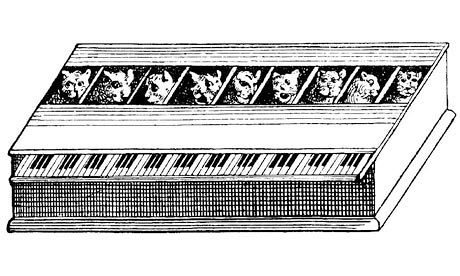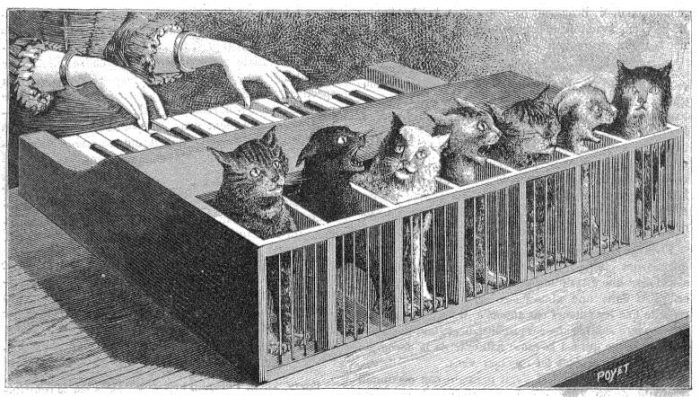[Most Recent Entries] [Calendar View]
Wednesday, July 31st, 2024
| Time | Event |
| 5:42a | Nick Cave Narrates an Animated Film about the Cat Piano, the Twisted 18th Century Musical Instrument Designed to Treat Mental Illness What do you imagine when you hear the phrase “cat piano”? Some kind of whimsical furry beast with black and white keys for teeth, maybe? A relative of My Neighbor Totoro’s cat bus? Or maybe you picture a piano that contains several caged cats who shriek along an entire scale when keys are pressed that slam sharpened nails into their tails. If this is your answer, you might find people slowly backing away from you at times, or gently suggesting you get some psychiatric help. But then, imagine that such a perverse oddity was in use by psychiatrists, like the 18th-century German physician Johann Christian Reil, who—reports David McNamee at The Guardian—“wrote that the device was intended to shake mental patients who had lost the ability to focus out of a ‘fixed state’ and into ‘conscious awareness.’” So long, meds. See you, meditation and mandala coloring books.… I joke, but apparently Dr. Reil was in earnest when he wrote in an 1803 manual for the treatment of mental illness that patients could “be placed so that they are sitting in direct view of the cat’s expressions when the psychiatrist plays a fugue.”  A bafflingly cruel and nonsensical experiment, and we might rejoice to know it probably never took place. But the bizarre idea of the cat piano, or Katzenklavier, did not spring from the weird delusions of one sadistic psychiatrist. It was supposedly invented by German polymath and Jesuit scholar Athanasius Kircher (1602–1680), who has been called “the last Renaissance man” and who made pioneering discoveries in the fields of microbiology, geology, and comparative religion. He was a serious scholar and a man of science. Maybe the Katzenklavier was intended as a sick joke that others took seriously—and for a very long time at that. The illustration of a Katzenklavier above dates from 1667, the one below from 1883.  Kircher’s biographer John Glassie admits that, for all his undoubted brilliance, several of his “actual ideas today seem wildly off-base; if not simply bizarre” as well as “inadvertently amusing, right, wrong, half-right, half-baked, ridiculous….” You get the idea. He was an eccentric, not a psychopath. McNamee points to other, likely apocryphal, stories in which cats were supposedly used as instruments. Perhaps, cruel as it seems to us, the cat piano seemed no crueler in previous centuries than the way we taunt our cats today to make them perform for animated GIFs. But to the cats these distinctions are meaningless. From their point of view, there is no other way to describe the Katzenklavier than as a sinister, terrifying torture device, and those who might use it as monstrous villains. Personally I’d like to give cats the last word on the subject of the Katzenklavier—or at least a few fictional animated, walking, talking, singing cats. Watch the short animation at the top, in which Nick Cave reads a poem by Eddie White about talented cat singers who mysteriously go missing, scooped up by a human for a “harpsichord of harm, the cruelest instrument to spawn from man’s gray cerebral soup.” The story has all the dread and intrigue of Edgar Allan Poe’s best work, and it is in such a milieu of gothic horror that the Katzenklavier belongs. The Cat Piano narrated by Nick Cave will be added to our list of Free Animations, a subset of our meta collection, 4,000+ Free Movies Online: Great Classics, Indies, Noir, Westerns, Documentaries & More Related Content: What People Named Their Cats in the Middle Ages: Gyb, Mite, Méone, Pangur Bán & More Cats in Japanese Woodblock Prints: How Japan’s Favorite Animals Came to Star in Its Popular Art Cats in Medieval Manuscripts & Paintings Josh Jones is a writer and musician based in Durham, NC. Follow him at @jdmagness |
| 8:00a | David Bowie Predicts the Good & Bad of the Internet in 1999: “We’re on the Cusp of Something Exhilarating and Terrifying” “We’re on the cusp of something exhilarating and terrifying.” The year is 1999 and David Bowie, in shaggy hair and groovy glasses, has seen the future and it is the Internet. In this short but fascinating interview with BBC’s stalwart and withering interrogator cum interviewer Jeremy Paxman, Bowie offers a forecast of the decades to come, and gets most of it right, if not all. Paxman dolefully plays devil’s advocate, although I suspect he did really see the Net as a “tool”– simply a repackaging of an existing medium. “It’s an alien life form that just landed,” Bowie counters. Bowie, who had set up his own bowie.net as a private ISP the previous year, begins by saying that if he had started his career in 1999, he would not have been a musician, but a “fan collecting records.” It sounded provocative at the time, but Bowie makes a point here that has taken on more credence in recent years–that the revolutionary status of rock in the ‘60s and ‘70s was tied to its rarity, that the inability to readily hear music gave it power and currency. Rock is now “a career opportunity,” he says, and the Internet now has the allure that rock once did. What Bowie might not have seen is how quickly that allure would wear off. The Internet no longer has a mystery to it. It’s closer to a public utility, oddly a point that Bowie makes later when talking about the invention of the telephone. Bowie also approved of the demystification between the artist and audience that the Internet was providing. In his final decade, however, he would seek out anonymity and privacy, dropping his final two albums suddenly without fanfare and refusing all interviews. He also didn’t foresee the kind of trolling that sends celebrities and artists off of social media. Paxman sees the fragmentation of the Internet as a problem; Bowie sees it as a plus. “The potential of what the Internet is going to do to society, both good and bad, is unimaginable.” There’s a lot more to unpack in this segment, and let your differing viewpoints be known in the comments. It’s what Bowie would have wanted. Related Content: David Bowie on Why It’s Crazy to Make Art–and We Do It Anyway (1998) How David Bowie Used William S. Burroughs’ Cut-Up Method to Write His Unforgettable Lyrics Ted Mills is a freelance writer on the arts who currently hosts the artist interview-based FunkZone Podcast. You can also follow him on Twitter at @tedmills, read his other arts writing at tedmills.com and/or watch his films here. |
| << Previous Day |
2024/07/31 [Calendar] |
Next Day >> |

